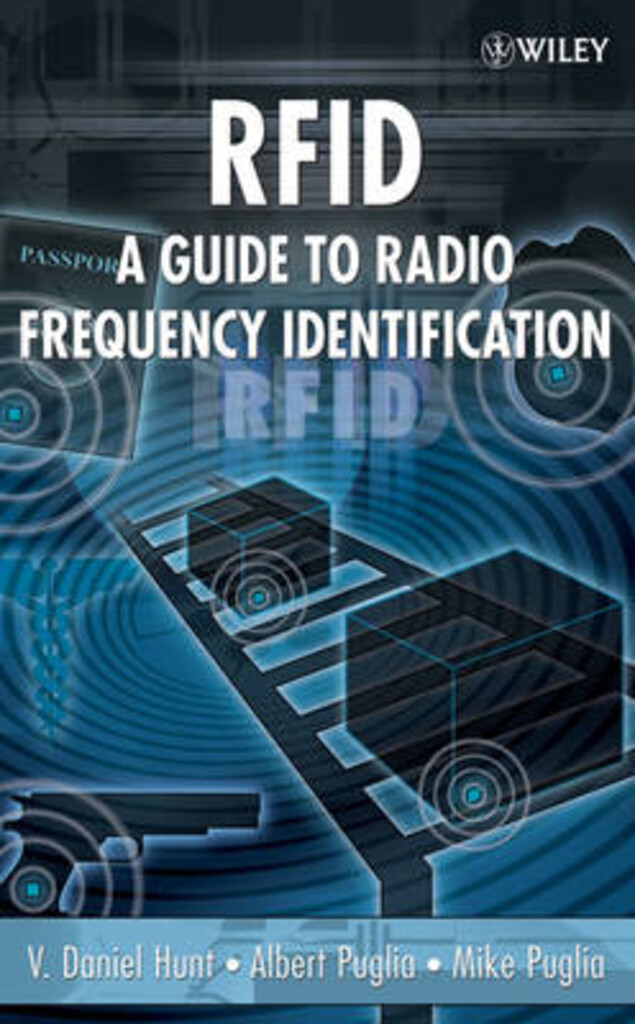RFID : A Guide to Radio Frequency Identification
V. Daniel. Hunt
Bok Engelsk 2007 · Electronic books.
| Annen tittel | |
|---|---|
| Utgitt | Hoboken : : Wiley, , 2007.
|
| Omfang | 1 online resource (240 p.)
|
| Opplysninger | Description based upon print version of record.. - RFID-A GUIDE TO RADIO FREQUENCY IDENTIFICATION; CONTENTS; PREFACE; ACKNOWLEDGMENTS; STAFF ACKNOWLEDGMENTS; ABOUT THE AUTHORS; 1 INTRODUCTION; 1.1 What Is RFID?; 1.2 What Explains the Current Interest in RFID Technology?; 1.3 Goals of This Book; 2 AN OVERVIEW OF RFID TECHNOLOGY; 2.1 The Three Core Components of an RFID System; 2.2 RFID Tags; 2.3 RFID Interrogators; 2.4 RFID Controllers; 2.5 Frequency; 2.6 Automatic Identification and Data Capture (AIDC) Systems; 2.7 "Smart" Tags vs. Bar Codes; 2.8 RFID Technology in Supply Chain Management; 3 HISTORY AND EVOLUTION OF RFID TECHNOLOGY. - 3.1 The Convergence of Three Technologies3.2 Milestones in RFID and the Speed of Adoption; 3.3 RFID in the Future; 4 RFID MIDDLEWARE AND INFORMATION TECHNOLOGY INTEGRATION; 4.1 What Is RFID Middleware?; 4.2 The Recent Focus on Middleware; 4.3 Core Functions of RFID Middleware; 4.4 Middleware as Part of an RFID System-The EPC Architecture; 4.5 The Present State of Middleware Development; 4.6 Middleware Vendors; 5 COMMERCIAL AND GOVERNMENT RFID TECHNOLOGY APPLICATIONS; 5.1 Introduction; 5.2 Effect of the Wal-Mart and Department of Defense Mandates. - 5.3 Strategic Dimensions of the Wal-Mart and DoD Mandates5.4 RFID Technology for Business Applications; 5.5 RFID and Supply Chain Management; 5.6 The Business Case for RFID; 5.7 Government Use of RFID Technology; 5.8 RFID and the Pharmaceutical Supply Chain; 5.9 RFID Implanted in Humans; 6 RFID TECHNOLOGY IN HOMELAND SECURITY, LAW ENFORCEMENT, AND CORRECTIONS; 6.1 Introduction; 6.2 RFID Technology in Homeland Security; 6.3 RFID in Law Enforcement; 6.4 RFID Use in Law Enforcement-Looking to the Future; 6.5 RFID Technology in Corrections; 7 RFID REGULATIONS AND STANDARDS. - 7.1 Governmental RFID Regulation7.2 World Regulatory Bodies; 7.3 Industrial-Scientific-Medical (ISM) Bands; 7.4 Spectrum Allocations for RFID; 7.5 Industrial RFID Standards; 7.6 International Standards Organization (ISO); 7.7 EPCglobal; 7.8 The Wal-Mart and DoD Mandates and EPC; 8 ISSUES SURROUNDING THE DEPLOYMENT OF RFID TECHNOLOGY; 8.1 Introduction; 8.2 Privacy Issues in Applying RFID Technology; 8.3 The Costs of Developing and Deploying RFID Technology; 8.4 The Growth of Global Standards and Regulations; 8.5 Technological Immaturity and Integration with Legacy Systems. - 8.6 Lack of Robustness8.7 Lack of Knowledge and Experience, End-User Confusion, and Skepticism; 8.8 Ethical Issues; 8.9 Data Management; 9 THE FUTURE PREDICTIONS FOR RFID; APPENDIX A WAL-MART RFID INITIATIVE; APPENDIX B DEPARTMENT OF DEFENSE RFID POLICY OVERVIEW; LIST OF ACRONYMS; GLOSSARY; RFID VENDOR LIST; POINTS OF CONTACT; INDEX. - This book provides an introduction to RFID technology. It describes and addresses the following: How RFID works, how it is and can be used in current and future applications. The History of RFID technology, the current state of practice and where RFID is expected to be taken in the future. The role of middleware software to route data between the RFID network and the information technology systems within an organization. Commercial and government use of RFID technology with an emphasis on a wide range of applications including retail and consumer packaging, transportation and distribution of
|
| Emner | |
| Sjanger | |
| Dewey | |
| ISBN | 0470107642. - 9780470107645
|
